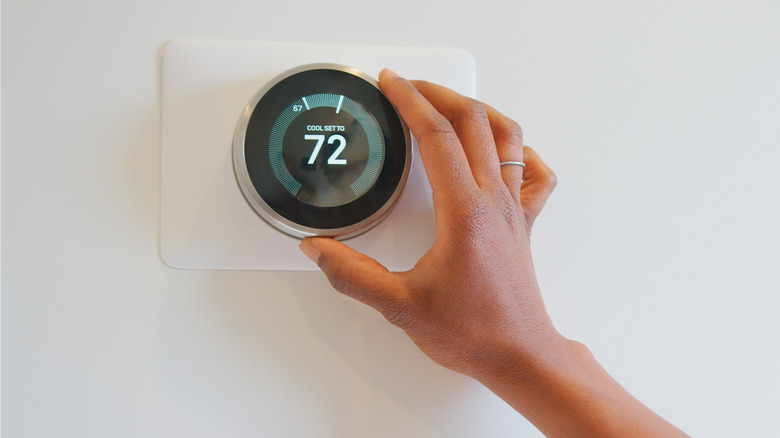Reduce Your Bills With A Popular Home Tech Item That HGTV's Mike Holmes Recommends
Ever wonder why your energy bills keep creeping up even when you haven't changed your daily habits? You're not alone. Many homeowners assume it's just the rising cost of living or that their A/C unit is to blame. But what if the real problem isn't the appliance itself but how it's being managed? This is the kind of overlooked detail that catches the attention of HGTV's Mike Holmes. Known for calling out outdated home systems that quietly cost homeowners money, Holmes believes one small change can make a surprisingly big difference in your long-term energy savings. He recommends upgrading to a smart thermostat as one of the most effective and practical ways to reduce energy bills and boost comfort in modern homes. On Facebook, Holmes writes, "I love using smart thermostats in my home because they make life easier! You can adjust the temperature and monitor energy usage right from your phone." With remote access and the ability to learn your routine, these thermostats replace inefficient, manual models. They are definitely among the top smart home products for homeowners.
However, before you consider switching, ensure HVAC compatibility. Yes, most smart thermostats can work with different types of HVAC systems, but it's wise to verify compatibility before making a purchase. It's equally important that you have a stable Wi‑Fi connection. This is necessary because to use remote control and scheduling features, your thermostat must be connected to your home Wi‑Fi. Also, ensure you pick one you can install easily. With the right DIY chops, most smart thermostats can be installed in around 30 minutes. Always follow the manufacturer's tutorials and double-check wiring.
How Smart Thermostats Save You Money
There are real-world examples and industry studies that back Mike Holmes' assertion that these devices are cost-saving. So if you're wondering whether smart thermostats are worth the hype, here are your answers. They cut heating and cooling bills by about 10 to 20 percent. Google's smart thermostat, Nest, reports savings of 12 percent on heating and 15 percent on cooling, while a different brand, Ecobee, reports 26 percent savings on cooling and heating.
But how exactly do these thermostats save your energy? Through automation. Automated scheduling prevents wasted energy and is one of the easiest ways to save money on your cooling bill. Smart models learn patterns to turn off HVAC systems when you're away, avoiding human error and preventing the effect it has on monthly bills. It is also possible to adjust settings when there are lifestyle changes, so you can enjoy an entirely flexible lifestyle with smart thermostats.
These thermostats also have load‑shifting features. This feature enables some thermostats to use motion sensors or geofencing to reduce HVAC use during certain hours, resulting in energy rebates or utility savings. They also provide energy use and temperature data so you can track and manage your energy use. Periodic software updates ensure your smart thermostat is using the latest algorithms and energy-saving features available. Combined, these optimizations translate into monthly bill reductions and long-term payback, making a smart thermostat one of Holmes's favorite energy-efficient upgrades.
Benefits of Smart Thermostats Beyond Savings
With smart thermostats, the value goes beyond lower bills. They have remote control and monitoring that gives you the ability to adjust temperatures or view energy usage from anywhere via a smartphone. Holmes praises the convenience and reassurance this provides, saying on his podcast via YouTube, "I can control my thermostat, which I love... I could be in New York, and all of a sudden I find out I've got to change the temperature in the house; I can do that, so to me that's smarter." They provide maintenance reminders and alerts, notifying you when it's time to replace filters or when your HVAC might have performance issues, helping prevent system inefficiencies. There's improved home comfort and longevity as smart thermostats reduce wear-and-tear by avoiding unnecessary HVAC cycles. Fewer cycles not only save energy but also extend equipment life.
A smart thermostat can attract potential insurance discounts, as some insurers reward homes with smart tech because it signals proactive management and can reduce claim risk. And holistically, a smart thermostat fits into Holmes' philosophy of "doing things right." It's one upgrade that pays for itself through comfort, energy efficiency, and stress-free operation. Bottom line, if your home still relies on a basic thermostat, you could be wasting hundreds of dollars a year and not even know it.


